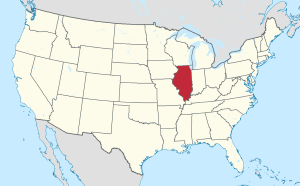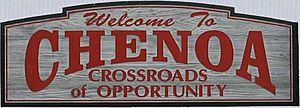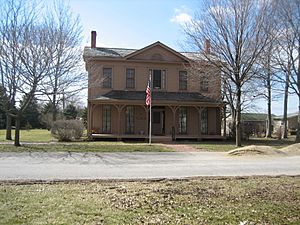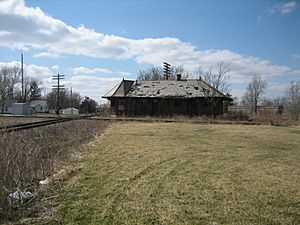Chenoa, Illinois facts for kids
Quick facts for kids
City of Chenoa
|
|
|---|---|
| Motto(s):
Crossroads of Opportunity
|
|

Location of Chenoa in McLean County, Illinois.
|
|

Location of Illinois in the United States
|
|
| Country | United States |
| State | Illinois |
| County | McLean |
| Township | Chenoa |
| Founded | 1854 |
| Area | |
| • Total | 2.47 sq mi (6.40 km2) |
| • Land | 2.43 sq mi (6.29 km2) |
| • Water | 0.04 sq mi (0.11 km2) |
| Elevation | 719 ft (219 m) |
| Population
(2020)
|
|
| • Total | 1,720 |
| • Density | 707.82/sq mi (273.27/km2) |
| Time zone | UTC−6 (CST) |
| • Summer (DST) | UTC−5 (CDT) |
| ZIP Code |
61726
|
| Area code(s) | 815 |
| FIPS code | 17-12931 |
| GNIS ID | 2393816 |
Chenoa is a small city in McLean County, Illinois, United States. In 2020, about 1,720 people lived there. Chenoa is special because it sits where three important roads meet: Interstate 55, Historic Route 66, and U.S. Route 24.
The city was started in 1854 by Mathew T. Scott. He wanted to create a place for his farm workers to buy things and for farmers to ship their grain. Chenoa is in a very good farming area. Every year, the city holds a fun celebration for the Fourth of July.
Contents
Where is Chenoa Located?
Chenoa is located at 40°44′35″N 88°43′12″W / 40.74306°N 88.72000°W. It covers about 2.47 square miles (6.4 square kilometers), with most of that being land.
The land around Chenoa, especially in McLean County, has some of the best soil in the world for farming. This rich soil helps grow a lot of corn and soybeans, making McLean County a top producer in Illinois.
Chenoa's Weather
Chenoa has a climate with hot, humid summers and cold, somewhat drier winters. This means you'll experience all four seasons clearly. The time when plants can grow without frost is about 173 days long.
| Climate data for Chenoa, Illinois (1991–2020 normals, extremes 1951–present) | |||||||||||||
|---|---|---|---|---|---|---|---|---|---|---|---|---|---|
| Month | Jan | Feb | Mar | Apr | May | Jun | Jul | Aug | Sep | Oct | Nov | Dec | Year |
| Record high °F (°C) | 67 (19) |
73 (23) |
85 (29) |
91 (33) |
96 (36) |
102 (39) |
105 (41) |
103 (39) |
100 (38) |
92 (33) |
79 (26) |
72 (22) |
105 (41) |
| Mean daily maximum °F (°C) | 31.7 (−0.2) |
36.5 (2.5) |
49.2 (9.6) |
62.4 (16.9) |
73.4 (23.0) |
81.7 (27.6) |
83.9 (28.8) |
82.3 (27.9) |
77.1 (25.1) |
64.4 (18.0) |
48.9 (9.4) |
36.7 (2.6) |
60.7 (15.9) |
| Daily mean °F (°C) | 23.4 (−4.8) |
27.7 (−2.4) |
39.0 (3.9) |
50.8 (10.4) |
62.0 (16.7) |
70.8 (21.6) |
73.4 (23.0) |
71.5 (21.9) |
65.2 (18.4) |
53.4 (11.9) |
40.0 (4.4) |
29.0 (−1.7) |
50.5 (10.3) |
| Mean daily minimum °F (°C) | 15.2 (−9.3) |
18.8 (−7.3) |
28.8 (−1.8) |
39.1 (3.9) |
50.6 (10.3) |
59.9 (15.5) |
63.0 (17.2) |
60.7 (15.9) |
53.3 (11.8) |
42.4 (5.8) |
31.0 (−0.6) |
21.3 (−5.9) |
40.3 (4.6) |
| Record low °F (°C) | −25 (−32) |
−22 (−30) |
−6 (−21) |
7 (−14) |
22 (−6) |
36 (2) |
45 (7) |
37 (3) |
24 (−4) |
17 (−8) |
−4 (−20) |
−26 (−32) |
−26 (−32) |
| Average precipitation inches (mm) | 2.17 (55) |
1.59 (40) |
2.68 (68) |
3.57 (91) |
4.52 (115) |
3.81 (97) |
3.74 (95) |
3.17 (81) |
3.13 (80) |
3.23 (82) |
2.63 (67) |
2.03 (52) |
36.27 (921) |
| Average snowfall inches (cm) | 5.3 (13) |
4.8 (12) |
2.3 (5.8) |
0.8 (2.0) |
0.0 (0.0) |
0.0 (0.0) |
0.0 (0.0) |
0.0 (0.0) |
0.0 (0.0) |
0.0 (0.0) |
1.3 (3.3) |
5.4 (14) |
19.9 (51) |
| Average precipitation days (≥ 0.01 in) | 6.5 | 4.8 | 7.8 | 10.5 | 11.1 | 9.1 | 8.1 | 7.6 | 6.9 | 8.9 | 8.1 | 6.6 | 96.0 |
| Average snowy days (≥ 0.1 in) | 2.8 | 2.5 | 1.5 | 0.4 | 0.0 | 0.0 | 0.0 | 0.0 | 0.0 | 0.0 | 0.8 | 3.1 | 11.1 |
| Source: NOAA | |||||||||||||
Who Lives in Chenoa?
| Historical population | |||
|---|---|---|---|
| Census | Pop. | %± | |
| 1880 | 1,063 | — | |
| 1890 | 1,226 | 15.3% | |
| 1900 | 1,512 | 23.3% | |
| 1910 | 1,314 | −13.1% | |
| 1920 | 1,311 | −0.2% | |
| 1930 | 1,325 | 1.1% | |
| 1940 | 1,401 | 5.7% | |
| 1950 | 1,452 | 3.6% | |
| 1960 | 1,523 | 4.9% | |
| 1970 | 1,860 | 22.1% | |
| 1980 | 1,847 | −0.7% | |
| 1990 | 1,732 | −6.2% | |
| 2000 | 1,845 | 6.5% | |
| 2010 | 1,785 | −3.3% | |
| 2020 | 1,720 | −3.6% | |
| Decennial US Census | |||
In 2020, there were 1,695 people living in Chenoa. There were 790 households, and 451 of them were families. Most people (about 94%) were White.
About 34% of households had children under 18. Most families (62.8%) were married couples living together. The average household had about 2.59 people.
The population was spread out by age:
- 27.6% were under 18
- 29.4% were between 25 and 44
- 15.0% were 65 or older
The average age in Chenoa was 36 years old.
Chenoa's History
How Chenoa Was Founded
The town of Chenoa was officially started on May 13, 1856, by Matthew T. Scott. He was a skilled land developer from Kentucky. Scott bought thousands of acres of land in the area starting in 1854.
He planned Chenoa where he expected two important railroads to cross: the Chicago and Alton Railroad and the Toledo, Peoria and Western. This crossing would make Chenoa a great place for trade.
The Name Chenoa
There are many stories about where the name "Chenoa" came from. Some people thought it meant "Dark and Bloody Ground" in an Indian language, but this is not correct. Others believed it was a Cherokee word for "Dove" or "White Dove," which is also untrue.
A common story says that Matthew T. Scott wanted to name it "Chenowa," but the railroad accidentally dropped the "w." This is also false, as Scott himself spelled it "Chenoa" from the start. However, "Chenoka" or "Chenoa" is a Native American name for the Kentucky River. This might be where Scott got the idea for the name.
How Chenoa Was Designed
Chenoa's layout is a bit tricky because it combines two different town plans. Matthew T. Scott's original town, west of the railroad, had a central park. This was common for towns built earlier in Illinois.
But a rival, William Marshall, owned land east of the railroad. He created his own town called East Chenoa. Scott even kept a small strip of land between the two towns. He called it his "imaginary wall" because he wouldn't let anyone build on it. This made it hard to go directly from one town to the other.
Selling Lots in Chenoa
The first advertisement for Chenoa appeared on May 15, 1856. It highlighted the town's great location where the railroads would cross. Scott promised that coal and lumber would be easy to get by train. This was a big deal because people would travel far to get these goods.
He also offered special deals for people who built houses. If you built a house worth $400-$500 within six months, you could get two years of interest-free credit on your land. Scott even offered free land for churches, schools, and cemeteries. He also said that anyone who sold alcohol in town would lose their property.
Chenoa Grows and Develops
When Chenoa was founded, the land around it was mostly wild prairie. The Native American tribes who lived there had been moved away by the U.S. Government. Soon, farmers began to plow the tough prairie soil, turning it into rich farmland.
Matthew T. Scott helped by plowing and farming 16,000 acres (65 square kilometers) himself. He also built 200 houses and planted many miles of fences. The first buildings in Chenoa were small dugouts used by railroad workers.
In 1855, J. B. Lenney came from Pennsylvania and opened "The Farmer's Store." He helped the town grow so much that he is known as the "Father of Chenoa." In 1864, Chenoa and East Chenoa finally joined together under one town government.
Continued Growth and Changes
Over time, Chenoa continued to improve. Streets were paved, and many trees were planted. The Chicago and Alton Railroad added a second track in 1890. In 1891, the town got its first electric lights!
A shared train station was built for both railroads, but it sadly burned down in 1918. In 1894, a big fire destroyed most of the businesses east of the railroad.
Train traffic was busiest in 1911. But as cars and trucks became more popular, Chenoa became a stop on the famous Route 66. Today, Chenoa is home to a few long-standing businesses and some antique shops. It is also the main office for the Bright Stalk Wind Farm.
Important Historical Buildings
The Matthew T. Scott House was built for Matthew T. Scott, the founder of Chenoa. The house is actually two buildings joined together. The older part was built in 1855, and the front part was added in 1863.
Many important family events happened here. For example, Adlai E. Stevenson I (who later became the 23rd Vice President of the United States) married Scott's sister-in-law in this house in 1866.
By 1980, the house was in bad shape. But it was bought and fixed up by Mrs. Elizabeth Stevenson Ives, a relative of Matthew T. Scott. In 1982, it was added to the National Register of Historic Places, which means it's a very important historical site.
Famous People from Chenoa
- Stan Albeck: A basketball coach for teams like the Chicago Bulls and San Antonio Spurs. He was born and went to high school in Chenoa.
- Lewis Stevenson: An Illinois Secretary of State. He was born in Chenoa. His father was Vice President Adlai Stevenson I, and his son was presidential candidate Adlai Stevenson II.
- Marty Roberts: An American radio DJ, songwriter, TV personality, and actor. He was born and went to high school in Chenoa.
See also
 In Spanish: Chenoa (Illinois) para niños
In Spanish: Chenoa (Illinois) para niños





